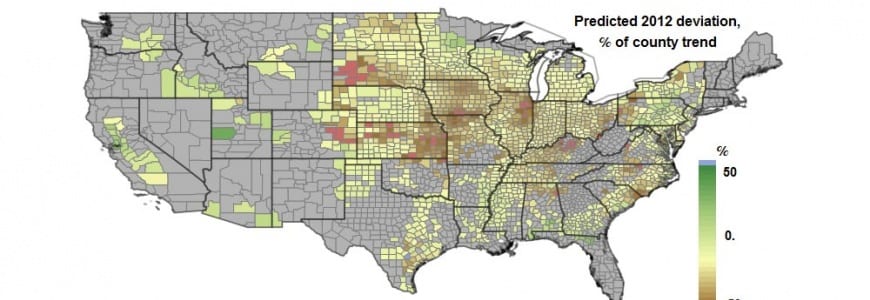By Rob Mitchum // April 19, 2013
[This article ran originally at International Science Grid This Week. Reprinted with permission.]
In 2012, the United States suffered its worst agricultural drought in 24 years. Farmland across the country experienced a devastating combination of high temperatures and low precipitation, leading to the worst harvest yields in nearly two decades. At its peak, nearly two-thirds of the country experienced drought conditions according to the US Drought Monitor. Worse still, instead of an anomalous year of bad weather, 2012 may have provided an alarming preview of how climate change will impact the future of agriculture.
These warning signs make 2012 an ideal year for validating crop yield and climate impact models that simulate the effects of climate on agriculture. Current climate change models predict that global temperatures could rise several degrees over the next century, making hotter growing seasons the new norm and truly extreme seasons (like 2012) more commonplace.
“A world four degrees warmer than it is now is not a world that we’ve ever seen before,” says Joshua Elliott, a fellow at the Computation Institute and the Center for Robust Decision-Making on Climate and Energy Policy. “Studying years like 2012 in detail can potentially be very useful for helping us understand whether our models can hope to accurately capture the future.”
In a recent working paper, Elliott and several colleagues simulate the effects of 2012’s drought on the county-level corn yield across the United States. The study uses Elliott’s parallel System for Integrating Impact Models and Sectors (pSIMS), a multi-model, high performance computing framework that fuses independent climate and agriculture models at large scales.
The pSIMS framework is written in Swift, an open source parallel scripting language developed at the Computation Institute, and prototyped through the University of Chicago Computing Cooperative (UC3) campus grid, the Open Science Grid (OSG), and XSEDE. “The Open Science Grid provided us with easy access to compute resources an order of magnitude larger than we otherwise could have gotten from campus clusters,” Elliot says.
“The goal is to create a probabilistic framework to estimate and forecast climate change impacts on a variety of temporal and spatial scales – ranging from local field scale all the way up to continental and global scales – and in time ranging from seasonal scales to multi-decadal climate change scales,” explains Elliott. “We’re creating this to run all of the different models at once using the same set of assumptions and scenarios.”
In the project’s first phase, the team produced a “zero lead time forecast” of the 2012 growing season, along with 1979-2011 “hindcasts” driven by observational weather data from planting through harvest. When compared to the actual county-level results released by the US Department of Agriculture (USDA) in February 2013, this data will help validate the model and improve the underlying mechanics. Subsequent studies will add lead time to test how early accurate predictions can be made about the year’s harvest. This will enhance farmers’ and decision makers’ abilities to adjust to seasons of adverse weather.
The simulations can also offer guidance through counterfactual experiments in which weather conditions from different years are swapped. When Elliott and colleagues test the effects of 1988’s drought conditions on the 2012 agricultural system, the simulated impact on the year’s corn harvest is nearly halved. Conversely, when 2012’s weather is combined with the agricultural conditions of 1988, the decrease in corn yield is significantly worse.
These differences suggest that adaptations developed between 1988 and 2012 have made US corn crops more robust in the face of drought conditions. Elliott plans to use pSIMS to reveal these protective characteristics, hypothesizing that new technologies, corn breeds, and farming practices – such as earlier planting dates – are responsible for improved resilience. Elliott’s models may also help predict the impact of the climate this year, which experts say is already off to a far worse start for drought conditions than in 2011 and 2012.

